Though not addressed in this edition of the Pest Report, Spinach downy mildew was spotted in Maine this week. It would be good to scout your spinach if you get a chance, as we want to make sure that this isn’t spreading to other farms. More info on spinach downy mildew here.
Onion thrips have been spotted in Massachusetts and though slowed by the recent cooler weather, will likely increase in numbers if hot and dry weather returns. Another pest that thrives in dry conditions, and has been spotted in Maine this week, is the cabbage aphid.
Overwintered Colorado potato beetles have emerged and started seeking out potatoes or eggplant to lay eggs upon. UMass Extension made a nice quick Instagram video showing beetle and eggs in a field previously planted to potatoes.
Striped cucumber beetle and three lined potato beetles also appear to be showing up after last week’s warmth.
Onion Thrips
Colorado Potato Beetle
Striped Cucumber Beetle
Cabbage Aphids
Three Lined Potato Beetle
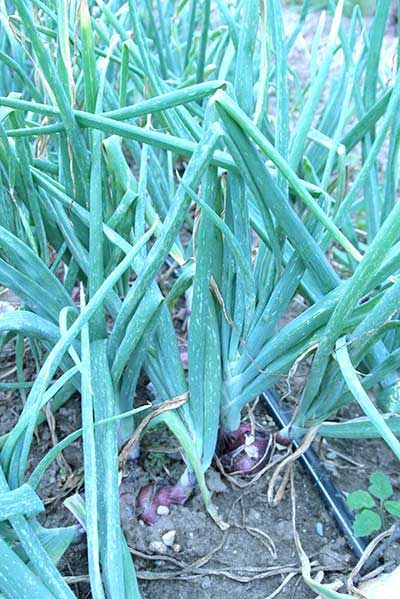 |
| Damage to onion leaves caused by thrips |
ONION THRIPS
By Eric Sideman
Onion thrips are active already, and if they have been a problem for you in years past it is time to start scouting for them. They are very tiny and easily overlooked until the onion plants start showing leaves that look as if they have been rasped. In fact they have. The thrips feed by using their mouth parts to rasp and pierce the onion leaves, releasing juices for them to feed upon. If the population of thrips is large you will see silvery patches on all the young leaves and when really bad the whole field will look white and silvery and the leaves wither. Obviously onion yields can be greatly reduced because the onion plant loses food and water through the damaged tissue. It is best to get control of them before their populations grow.
Onion thrips hide between the leaves at the base of the onion plant. I find the best way to find them is to pull up a plant and hold it upside down over a white sheet of paper and pull apart the leaves as you shake gently. Even when they are walking about on the paper you will still need to look hard to see the thrips. My eyes are not that good and I need a hand lens to even spot them. Immature thrips are white to a pale yellow, elongated with very short antennae and dark eyes. Remember, tiny. The adult is tiny too, but it has wings. Thrips’ wings are unique. They are fringed with hairs. Thrips are very poor fliers, but they do fly when disturbed, and they do get blown in the wind easily, so they may move long distances. Keep in mind that this means thrips can be blown to new fields downwind. Adults are pale yellow to dark brown.
There are many generations per season and they can reproduce very quickly in warm weather. Also, parthenogenesis is common, meaning females that cannot find males produce progeny all by themselves. Each female can produce up to 80 eggs, which tells you that the population can explode quite quickly under good conditions. Good conditions are warm and without heavy rains. Heavy rains wash the weak insect off the plant. Growers can simulate heavy rains with heavy overhead irrigation. As well as disturbing the insect, the extra water will help the rasped onions. Extra fertilization will help too.
Thrips survive in onion and garlic debris so clean up after harvest. Also, thrips hide in the garlic bulb for the winter, so you may have “planted” them when you planted the garlic in the fall. I have heard that thrips are confused by inter-cropping with carrots, and have a harder time finding your crop.
If natural enemies or cultural practices fail to keep thrips populations down then you may need to turn to a pesticide. Remember, thrips are often around in small numbers which can be tolerated. IPM practices recommend an economic threshold of an average of 1 thrips per green leaf. When scouting, sample about 50 plants around the field from at least 10 different locations in the field and then figure the average per leaf. Entrust is the most common recommended material. Follow the label instructions and be sure to spray into the leaf axis. Surround is reported to deter thrips, and may be the better choice if you have had bad thrips problems in the past. See the summer 2013 edition of The Maine Organic Farmer & Gardener for an excellent article about onion thrips by Tom Vigue.
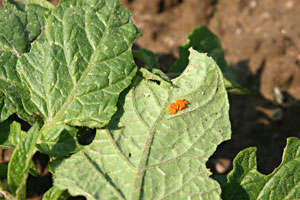 |
| Colorado potato beetle eggs |
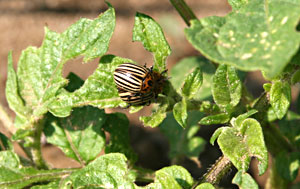 |
| Adult Colorado potato beetle |
COLORADO POTATO BEETLE
Colorado potato beetle (CPB) adults are starting to show up in potato and eggplant crops. The bright orange-yellow eggs are laid in clumps with about 30-35 eggs each, generally on the undersides of leaves. As with most other insects and plants, there is a direct relationship between higher temperatures (in the range between about 55 and 90 degrees F) and faster rate of development. That includes egg-laying, egg hatch, larval growth, and feeding rates. A period of cold, rainy weather slows everything down, but we can expect a surge of adults and shiny yellow eggs to appear with the next hot spell.
Scouting and Thresholds
Walk your fields NOW and look for CPB adults and eggs. A treatment should be considered for adults when you find 25 beetles per 50 plants and defoliation has reached the 10% level. The spray threshold for small larvae is 4 per plant; for large larvae, 1.5 per plant (or per stalk in midseason), based on a count of 50 plants or stalks.
Controls are needed on eggplants when there are 2 small or 1 large larvae per plant (if plants are less than six inches) and 4 small larvae or 2 large per plant (if plants are more than six inches).
Potatoes can tolerate 20% defoliation without reduction in yield (or even more late in the season). Damage to eggplant seedlings from adult feeding is often severe enough to warrant control of the adults. In potato, adult damage in rotated fields may not be significant, so you may be able to wait until after egg hatch to kill both late adults and larvae.
Look on the undersides of leaves for the orange-yellow egg masses. The fresherthe eggs, the brighter orange the eggs will appear. Eggs hatch in 7-10 days, depending on temperature. If you want to know when the earliest eggs are hatching, you can flag a few of the earliest egg masses you find with bright tape or flags, and then keep an eye on the hatch.
Hatched larvae go through four stages before they become adults. In the first stage, the larvae are about the same size as the eggs and in the second stage they are about an eighth of an inch long. As the larvae get bigger, they do more feeding. The fourth, or largest, stage does 85% of the feeding damage. It’s a good idea to prevent larvae from ever reaching the fourth instar! The smaller instars are the easiest to kill.
After larvae complete their growth, they drop to the ground and burrow into the ground to pupate. About ten days later, the next generation of adults emerges – ready to feed. If they emerge before August 1, they will lay more eggs. After August 1, they feed and head to overwintering sites. Good control in June prevents problems with CPB in August.
Cultural Controls
Crop Rotation. The single most important tactic for CPB management is to rotate potatoes or eggplant to a field that is at least 200 yards from the previous year’s fields. Since the adults that emerge after winter rarely fly, barriers such as roads, rivers, woodlands, and fields with other crops are helpful. Rotated fields tend to be colonized (from second generation adults that are likely to fly) 1-4 weeks later in the season than non-rotated fields. Also, the total population of adult beetles is lower, producing fewer larvae to control.
Perimeter treatments or perimeter trap cropping can be applied to potato. One approach is to plant a barrier crop between overwintering sites and this year’s crop and get it in earlier than the main crop; then control early-arriving beetles.
Early planting. Green sprouting, also know as chitting, prepares whole seed potatoes to emerge rapidly, gaining about 7-10 days to harvest. This early start makes it easier for the crop to put on growth and size before CPB adults and larvae arrive. It can be combined with raised beds and plasticulture. While it won’t avoid damage altogether, it may reduce the need for insecticides. Refer to the New England Vegetable Management Guide for more details.
Late planting. Another strategy for beating the beetle is to plant late. CPB adults that do not find food leave the field in search of greener pastures. Planting after mid- June, using a short season variety, often avoids CPB damage and eliminates the need for controls.
Straw mulch. It has been well documented that when potato or eggplants are mulched with straw, fewer Colorado potato beetle adults will settle on the plants and fewer eggs will be laid. This can be accomplished on larger plantings by strip planting in a rye mulch, followed by mowing and pushing the rye straw over the plants after they emerge. For smaller plots, straw may be carried in.
Biological control. There are numerous predators and parasitoids that attack CPB adults, larvae, and eggs including a tachinid fly, 12-spotted ladybeetle, spined soldier bug, and ground beetles.
Organic Materials
Spinosad (Entrust, or Monterey Garden Insect Spray for home gardeners) and azadiractin (AZA-Direct) are two options. Studies have shown very good results with spinosad, but please use reluctantly because resistance is building up in populations of CPB. The azadiractin has shown some efficacy, but neem works slowly. Generally it is used to reduce overall damage and reduce numbers but it is not a rescue treatment like spinosad is. Beauvaria bassiana (Mycotrol ESO) has been shown to suppress CPB populations though does not provide immediate control.
NOTE: There are label restrictions on the use of Entrust that have been written in to help avoid build up of resistance. Be sure to follow the label with respect to mixing, AND number of times a particular crop may be sprayed per season.
(Modified from the Umass Vegetable Notes, an article by – R Hazzard; (sources include: D Ferro (UMass Amherst), J. Mishanec (NYS), J Boucher (CT), J. Whalen (DE), T. Kuhar (VA), G Ghidhu (NJ), New England Vegetable Management Guide, Ohio Vegetable Production Guide)
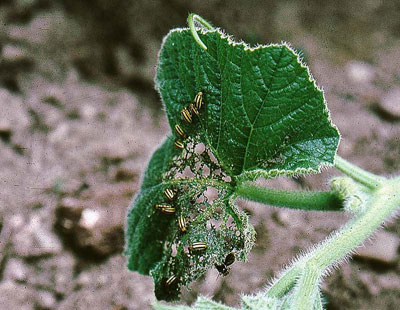 |
| Cucumber beetles and feeding damage |
STRIPED CUCUMBER BEETLE
Striped cucumber beetle is our most serious early-season pest in cucurbit crops. These beetles spend the winter in plant debris in field edges and with the onset of warm days and emergence of cucurbit crops they move rapidly into the field. Densities can be very high, especially in non-rotated fields or close to last year’s cucurbit crops. Adult feeding on cotyledons and young leaves can cause stand reduction, delayed plant growth, and reduced yield. The striped cucumber beetle also vectors Erwinia tracheiphila, the causal agent of bacterial wilt, and this can be much more damaging than direct feeding injury. Crop rotation, transplants, and floating row cover are cultural controls that help reduce the impact of cucumber beetles. Many growers use row covers on cucurbits for both growth benefit and insect protection, and remove when flowering begins. I remove the covers when I see the first female flower.
Avoid early season infection with wilt. Cucurbit plants at the cotyledon and first 1-2 leaf stage are more susceptible to infection with bacterial wilt than older plants, and disease transmission is lower after about the 4-leaf stage. Using row covers to keep the beetles out at this most vulnerable stage can be very effective.
Beetle numbers should be kept low, especially before the 5-leaf stage. Scout frequently (at least twice per week before emergence, and for two weeks after crop emergence) and treat after beetles colonize the field. The threshold depends on the crop. To prevent bacterial wilt in highly susceptible crops such as cucumber, muskmelons, summer squash, and zucchini, we recommend that beetles should not be allowed to exceed one beetle for every 2 plants. Less wilt-susceptible crops (butternut, most pumpkins) will tolerate 1 or 2 beetles per plant without yield losses. Spray within 24 hours after the threshold is reached.
Insecticides that are allowed in organic production (listed by OMRI, the Organic Materials Review Institute) include kaolin clay (Surround WP), pyrethrin (PyGanic Crop Spray 5.0 EC), and a mixture of pyrethrin and azadiractin (Azera). Surround should be applied before beetles arrive because it acts as a repellent and protectant, not a contact poison. With direct-seeded crops, apply as soon as seedlings emerge if beetles are active. Transplants can be sprayed or dipped before setting out in the field.
Perimeter trap cropping with a preferred cucurbit crop (usually a C. maxima such as ‘blue hubbard’ or ‘buttercup’) can give excellent control with a dramatic reduction in pesticide use. For details on using perimeter trap cropping, see Connecticut IPM Program’s Directions For Using a Perimeter Trap Crop Strategy to Protect Cucurbit Crops.
(Modified from the UMass. Vegetable Newsletter, original written by Ruth Hazzard & Andrew Cavanagh)
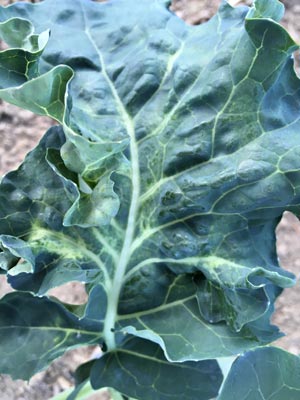 |
| Yellowing on a brassica leaf caused by cabbage aphids |
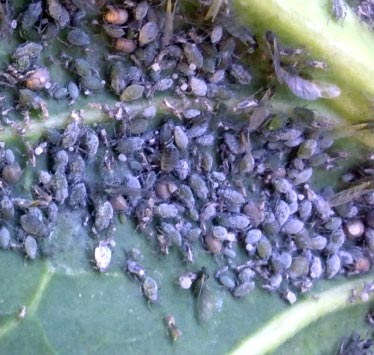 |
| Cabbage aphids – Brevicorynne brassicae |
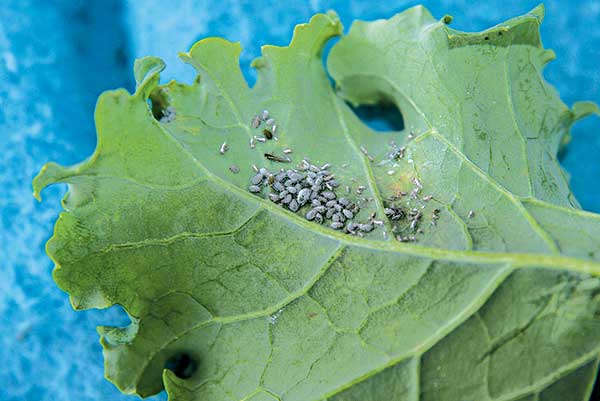 |
| Cabbage aphids on the underside of a leaf |
CABBAGE APHID
By Becky Sideman
Those who grow crops in the Brassica family are likely familiar with the cabbage aphid, Brevicoryne brassicae, sometimes referred to by growers as “gray aphid”. It is often a significant problem on fall brassica crops, especially Brussels sprout, kale, and broccoli. In recent years, many growers in northern New England have reported increasing crop losses caused by this pest, mostly on late fall brassicas. The earliest aphids are usually found in early summer.
Cabbage aphids have a distinctive whitish-gray appearance because they are covered with a white powdery wax coating. They are often found in thick clumps or colonies, feeding on the youngest tissue of Brussels sprouts, cabbage, broccoli, kale, and other members of the cabbage family.
Cabbage aphids overwinter as eggs laid on Brassica crops and weeds in the fall. The eggs hatch in early spring, giving rise to females that feed and produce live offspring. Winged aphids form after the initial infestations, and then fly to colonize new crops. In warmer climates, adults overwinter without producing eggs. It ispossible that adults can overwinter in unheated high tunnels containing brassica crops here in the north. Some key cultural practices to manage cabbage aphid populations include destroying and burying brassica crop and weed residue in order to bury the eggs, managing brassica weeds (mustards, etc.), and rotating brassica crops away from where cabbage aphids were previously found.
Cabbage aphids are difficult to control if detected late in the season when populations are already very high. (It is also difficult to get insecticides to penetrate their thick colonies and into the crevices where they hide within the plant). Scout early and often, so that you know when they arrive. While the aphids themselves can be difficult to see, especially in small numbers, they produce a visible yellowing on the leaves. When you see this symptom as you walk the field, it is a good idea to examine plants more closely. Young broccoli showing characteristic yellowing where cabbage aphids have been feeding.
When there are only a couple of infested plants, you can rogue or remove those plants, or possibly even mechanically destroy the initial aphids. Because the winged aphids are distributed randomly, it is important to scout thoroughly on a weekly basis. Economic thresholds suggest that you should treat if at least 10% of the plants are infested. You can also follow this UC Davis sequential sampling procedure, to reduce time spent scouting. Colleagues at UMass created a helpful Brassica scouting sheet, which helps you record the presence of all major brassica pests in one place.
Recent research by the UMass Extension Vegetable Program and at the N.H. Agricultural Experiment Station have shown that decent control of cabbage aphid using organically approved insecticides is possible, but that it requires a regular scouting regime and repeated applications (we have used up to 7-8 applications per season), increasing in frequency later in the season as aphid populations climb. There are also many conventional options, but timely application and rotation between insecticide options is key. In all cases, getting good coverage and use of appropriate spreader stickers (following label recommendations) is critical.
For additional information about this pest, see the following useful resources:
University of California Pest Management Guidelines for Cabbage Aphid
Cabbage Aphid – within the New England Vegetable Management Guide
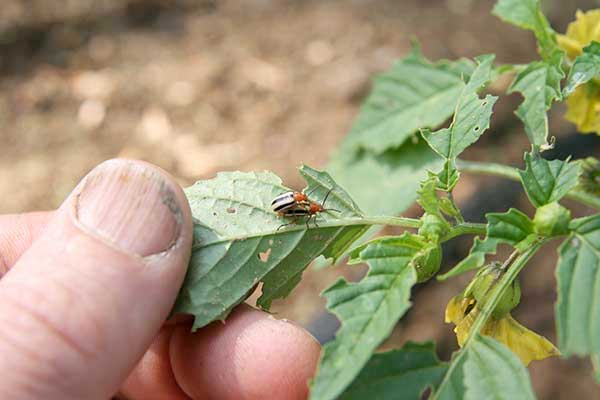 |
| Three-lined potato beetles |
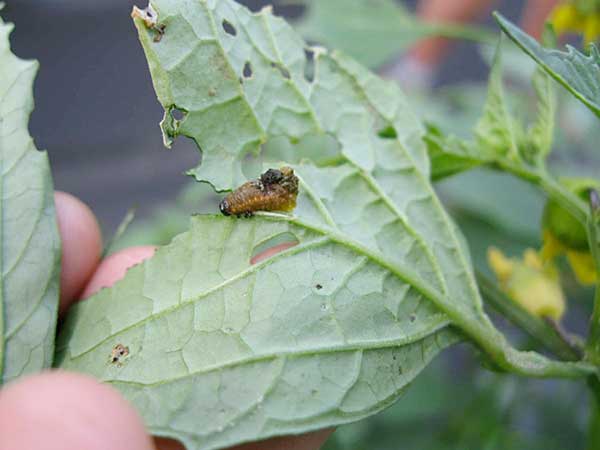 |
| Three lined potato beetle larva |
THREE-LINED POTATO BEETLE (Lema daturaphila)
By Eric Sideman
Cucumber beetles on my potatoes and tomatillo?
No. Those are not cucumber beetles. Potatoes, tomatoes and sometimes eggplants are attacked by the three-lined potato beetle that only superficially looks like a cucumber beetle. Its favorite food is tomatillo and husk cherries (both are Physalis species). The adult of this pest is about the same size as a cucumber beetle but has a reddish head and a thorax with two dark spots.The wing covers are dark yellow with three black stripes.
The Three-Lined Potato Beetle overwinters as an adult and wakes early in the spring. They are there waiting for you to plant your solanaceous crops. The females soon begin laying eggs that hatch in about two weeks to larvae that look a bit like Colorado potato beetle larvae, except these critters have the endearing practice of carrying a small pile of their own excrement on their back. The larvae mature in about two weeks. There are probably two generations per year.
On most crops, the damage from this pest does not warrant control. If three-lined potato beetle has been a problem in the past, floating row covers will help you avoid the overwintering adults and that should get you by. Hand picking will work on small plantings. Pyrethrin (Pyganic) or spinosad (Entrust, or Monterey Garden Insect Spray for home gardeners) may offer some relief.

This material is based upon work supported by the National Institute of Food and Agriculture, U.S. Department of Agriculture, through the Northeast Sustainable Agriculture Research and Education program under subaward number ONE19-334.
Any opinions, findings, conclusions, or recommendations expressed in this publication are those of the author(s) and do not necessarily reflect the view of the U.S. Department of Agriculture.
